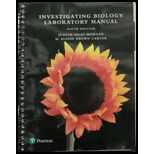
Investigating Biology Laboratory Manual (9th Edition)
9th Edition
ISBN: 9780134473468
Author: Lisa A. Urry, Michael L. Cain, Steven A. Wasserman, Peter V. Minorsky, Jane B. Reece, Judith Giles Morgan, M. Eloise Brown Carter
Publisher: PEARSON
expand_more
expand_more
format_list_bulleted
Concept explainers
Question
Chapter 20.4, Problem 3CC
Summary Introduction
To determine: The lab tests and its results to rule out the presence of hepatitis A infection in the given patient.
Concept introduction:
To detect a known RNA sequence, methods such as reverse transcriptase polymerase chain reaction (RT-PCR) or RNA sequencing can be used. In both the cases, mRNA is first converted to complementary DNA (cDNA) and then analyzed. Hepatitis A is categorized as an RNA virus. Hepatitis A infection can be detected in the blood or tissue through these methods.
Expert Solution & Answer
Trending nowThis is a popular solution!

Students have asked these similar questions
What are biofertilizers and mention the significance
PCBs and River Otters: Otters in Washington State’s Green-Duwamish River have high levels of polychlorinated biphenyls (PCBs) in their livers. PCBs can bind to the estrogen receptors in animals and disrupt the endocrine system of these otters. The PCBs seem to increase the estrogen to androgen ratio, skewing the ratio toward too much estrogen.
How would increased estrogen affect the river otter population?
Based on your reading of the materials in this unit, what factors can affect fertility in humans?
Explain how each of the factors affecting human fertility that you described can disrupt the human endocrine system to affect reproduction.
Other than oil and alcohol, are there other liquids you could compare to water (that are liquid at room temperature)?
How is water unique compared to these other liquids?
What follow-up experiment would you like to do, and how would you relate it to your life?
Chapter 20 Solutions
Investigating Biology Laboratory Manual (9th Edition)
Ch. 20.1 - Prob. 1CCCh. 20.1 - DRAW IT One Strand of a DNA molecule has the...Ch. 20.1 - What are some potential difficulties in using...Ch. 20.1 - VISUAL SKILLS Compare Figure 20.7 with Figure...Ch. 20.2 - Prob. 1CCCh. 20.2 - Prob. 2CCCh. 20.3 - Based on current knowledge, how would you explain...Ch. 20.3 - Prob. 2CCCh. 20.3 - Prob. 3CCCh. 20.4 - What is the advantage of using stem cells for gene...
Ch. 20.4 - Prob. 2CCCh. 20.4 - Prob. 3CCCh. 20 - Describe how the process of gene doning results in...Ch. 20 - What useful Information is obtained by detecting...Ch. 20 - Describe how, using mice. a researcher could carry...Ch. 20 - What factors affecf whether a given genetic...Ch. 20 - In DNA technology, the term vector can refer to...Ch. 20 - Which of the following tools of DNA technology is...Ch. 20 - Prob. 3TYUCh. 20 - A paleontologist has recovered a bit of tissue...Ch. 20 - DNA technology has many medical applications....Ch. 20 - Which of the following is not true of cDNA...Ch. 20 - Expression of a cloned eukaryotic gene in a...Ch. 20 - Which Ii of the following sequences in...Ch. 20 - Prob. 9TYUCh. 20 - MAKE CONNECTIONS Looking at Figure 20.15, what...Ch. 20 - DRAW IT You are cloning an aardvark gene, using a...Ch. 20 - EVOLUTlON CONNECTION Ethical considerations aside,...Ch. 20 - Prob. 13TYUCh. 20 - Prob. 14TYUCh. 20 - The water in the Yellowstone National Park hot...
Knowledge Booster
Learn more about
Need a deep-dive on the concept behind this application? Look no further. Learn more about this topic, biology and related others by exploring similar questions and additional content below.Similar questions
- Selection of Traits What adaptations do scavengers have for locating and feeding on prey? What adaptations do predators have for capturing and consuming prey?arrow_forwardCompetition Between Species What natural processes limit populations from growing too large? What are some resources organisms can compete over in their natural habitat?arrow_forwardSpecies Interactions Explain how predators, prey and scavengers interact. Explain whether predators and scavengers are necessary or beneficial for an ecosystem.arrow_forward
- magine that you are conducting research on fruit type and seed dispersal. You submitted a paper to a peer-reviewed journal that addresses the factors that impact fruit type and seed dispersal mechanisms in plants of Central America. The editor of the journal communicates that your paper may be published if you make ‘minor revisions’ to the document. Describe two characteristics that you would expect in seeds that are dispersed by the wind. Contrast this with what you would expect for seeds that are gathered, buried or eaten by animals, and explain why they are different. (Editor’s note: Providing this information in your discussion will help readers to consider the significance of the research).arrow_forwardWhat is the difference between Uniporters, Symporters and Antiporters? Which of these are examples of active transport?arrow_forwardWhat are coupled transporters?arrow_forward
- How do histamine and prostaglandins help in the mobilization of leukocytes to an injury site? What are chemotactic factors? How do they affect inflammation process?arrow_forwardCompare and contrast neutrophils and macrophages. Describe two ways they are different and two ways they are similar.arrow_forwardDescribe the effects of three cytokines (not involved in the initial inflammation response). What cells release them?arrow_forward
arrow_back_ios
SEE MORE QUESTIONS
arrow_forward_ios
Recommended textbooks for you
 Biology: The Unity and Diversity of Life (MindTap...BiologyISBN:9781305073951Author:Cecie Starr, Ralph Taggart, Christine Evers, Lisa StarrPublisher:Cengage Learning
Biology: The Unity and Diversity of Life (MindTap...BiologyISBN:9781305073951Author:Cecie Starr, Ralph Taggart, Christine Evers, Lisa StarrPublisher:Cengage Learning Biology Today and Tomorrow without Physiology (Mi...BiologyISBN:9781305117396Author:Cecie Starr, Christine Evers, Lisa StarrPublisher:Cengage Learning
Biology Today and Tomorrow without Physiology (Mi...BiologyISBN:9781305117396Author:Cecie Starr, Christine Evers, Lisa StarrPublisher:Cengage Learning

Biology: The Unity and Diversity of Life (MindTap...
Biology
ISBN:9781305073951
Author:Cecie Starr, Ralph Taggart, Christine Evers, Lisa Starr
Publisher:Cengage Learning

Biology Today and Tomorrow without Physiology (Mi...
Biology
ISBN:9781305117396
Author:Cecie Starr, Christine Evers, Lisa Starr
Publisher:Cengage Learning